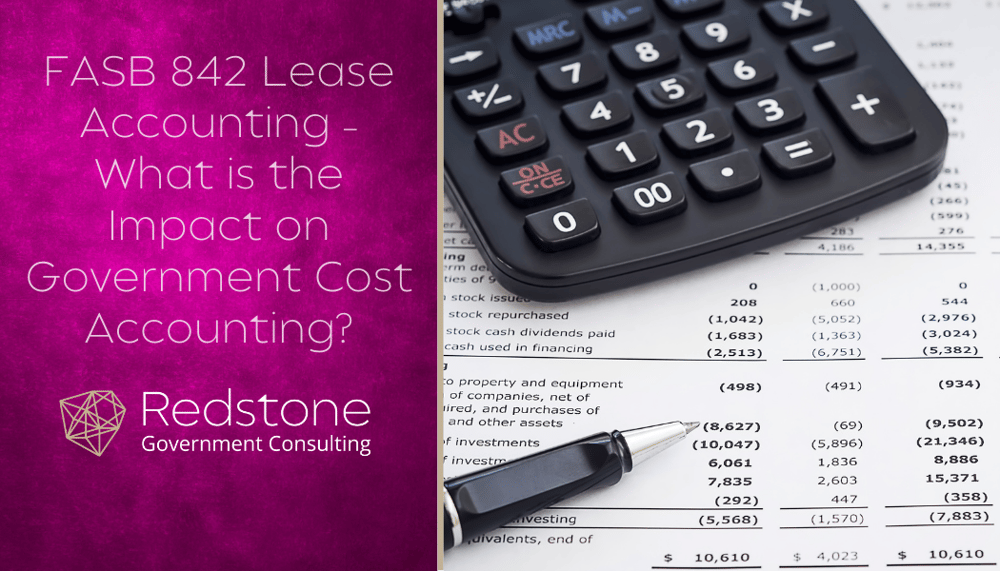
The Financial Accounting Standards Board (FASB) issued Topic 842, Leases, in February 2016 effective for fiscal years beginning after December 15, 2018. The change was “to increase transparency and comparability among organizations by recognizing lease assets and lease liabilities on the balance sheet and disclosing key information about leasing arrangements.” For the past 40 years or so, operating leases were only required to be presented in the disclosure and were off-balance sheet transactions. Other than the new asset (Right to Use asset) and a related liability on the balance sheet, the impact on the income statement (a single line item for lease expense) and cash flow are unchanged, at least under GAAP. International Financial Reporting Standards (IFRS) now requires all leases be treated similar to capital leases (Topic 842 calls these finance leases). So, under IFRS there will be more unallowable interest to properly account for on Government proposals and contracts incorporating FAR Part 31.
GAAP Impact
Fortunately for US based contractors applying GAAP, GAAP – unlike IFRS – is not requiring the operating leases to be treated as a financing transaction and the lease expense remains a single allowable line item of expense for contract costing. The next question is whether the new asset on the balance sheet has any impact. We do not believe it does. The most likely potential impact would have been to the net book value component of the three-factor formula used to allocate residual home office expenses under CAS 403. However, CAS 403-50(c)(1)(iii) specifically states “the average net book value of the sum of the segment's tangible capital assets.” ASBCA Case No. 60131 found that operating leases in relation to CAS 404 are intangible assets. We believe this same determination carriers over to CAS 403 and therefore operating leases should not be included in the calculation of the three-factor formula. The ASBCA based its decision on the plain language of CAS 404.
The CAS defines "tangible capital asset[s]" as "asset[s] that [have] physical substance, more than minimal value, and [are] expected to be held by an enterprise for continued use or possession beyond the current accounting period for the services it yields" (id.). Thus, the plain language of the CAS provides that CAS 404 applies to tangible assets which are assets with physical substance. A lease is an "intangible" rather than a tangible asset because the lease itself is a legal right to use and occupy the building and does not have "physical substance." (emphasis added)
We also believe the new Right to Use assets would not be part of the CAS 414 Facilities capital intangible capital assets that are subject to amortization. The GAAP treatment of operating leases on the income statement as a single line item of expense and cash flow within the operating activities show they are not recognizing the constructive costs of ownership and therefore do not meet the definition of “Leased property” in CAS 414 Instructions to Cost of Money form.
IFRS Impact
Contractors required to apply IFRS are going to be facing a situation of increased unallowable interest expense. While foreign concerns are exempt from CAS, they can claim cost of money under FAR 31.205-10, Cost of money. The requirement to treat all leases as finance (capital) leases should allow these contractors to include the net book value of these leased assets in the facilities capital calculation for cost of money as FAR 31.205-10(b)(1) requires CAS 414 be followed and leased property recognizing the constructive costs of ownership is included.
Work for the CAS Board and FAR Council
Ok, we all know the CAS Board has done next to nothing for years. However, from the CAS Board side the only issue truly needing to be addressed as a result of FASB 842 is the confusion the ASBCA introduced with its decision that leases are intangible assets. Unless DCAA comes in with some off-the-wall position we do not believe there is much risk here.
The FAR Council needs to update FAR 31.205-11, Depreciation, and 31.205-36, Rental cost, to change the reference to Financial Accounting Standards Board’s Accounting Standards Codification Topic 840, Leases, to Topic 842, Leases and the change from capital to finance leases.
Redstone GCI is available to assist contractor’s in determining the impact, if any, of leases on their contract cost accounting practices. Redstone GCI assists contractors throughout the U.S. and internationally with understanding the Government’s expectations in applying FAR and CAS (remember some CAS is incorporated into FAR Part 31, Cost Principles).


 John is a Director with Redstone Government Consulting, Inc. providing government contract consulting services to our clients primarily related to the DFARS business systems, CAS Disclosure Statements, and DCAA/DCMA compliance preparation, advisory, and defense. Prior to joining Redstone Government Consulting, John served in a number of capacities with DCAA/DCMA for more than 30 years. Upon his retirement, he was based in Texas as an SES-level Corporate Audit Director for DCAA, managing a staff of 300 auditors at one of the largest DOD programs. Professional Experience John began his career in the late 80s working in the Clearwater, FL audit office and over the next three decades he progressed through a number of positions within both DCAA and DCMA with career highlights as DCAA Program Manager at Ft. Belvoir, Chief of Technical Programs Division, Deputy Assistant Director-Policy, Director of the DCMA Cost and Pricing Center, the SES-level Lockheed Martin Corporate Audit Director, and Director of Integrity and Quality Assurance. John’s three decades of experience in performing and leading DCAA auditors and DCMA reviewers provides a wealth of expertise to our clients. John’s role, not only in the performance of audits, but also in the development of audit policy affords him unique insights into the defense of audit findings and the linkage of audit program steps to the underlying regulatory framework. He is an expert in FAR, DFARS, and other agency acquisition regulation, as well as a subject matter expert in the Cost Accounting Standards having reviewed and provided audit feedback on many of the largest and most complex cost accounting practices during his tenure with the DCAA. John’s tenure with DCAA and DCMA came at a critical time during each agency’s history where a number of changes were occurring such as the response to the ICS backlog, development of audit approaches to the DFARS Business Systems and implementation of new audit initiatives as a result of Congressional oversight through the NDAA process. John’s leadership at the DCMA Cost & Pricing center saw oversight of all major DOD pricing actions, leadership of should cost review teams, the Commercial Pricing group and many other areas of strategic value to our clients. His involvement in these and other Agency initiatives is of great value to our clients due to his in depth understanding of DCAA and DCMA’s internal policy directives. Education John holds a Master of Business Administration and a B.A. in Accounting from the University of South Florida. Certifications Certified Information Systems Auditor State of Alabama Certified Public Accountant
John is a Director with Redstone Government Consulting, Inc. providing government contract consulting services to our clients primarily related to the DFARS business systems, CAS Disclosure Statements, and DCAA/DCMA compliance preparation, advisory, and defense. Prior to joining Redstone Government Consulting, John served in a number of capacities with DCAA/DCMA for more than 30 years. Upon his retirement, he was based in Texas as an SES-level Corporate Audit Director for DCAA, managing a staff of 300 auditors at one of the largest DOD programs. Professional Experience John began his career in the late 80s working in the Clearwater, FL audit office and over the next three decades he progressed through a number of positions within both DCAA and DCMA with career highlights as DCAA Program Manager at Ft. Belvoir, Chief of Technical Programs Division, Deputy Assistant Director-Policy, Director of the DCMA Cost and Pricing Center, the SES-level Lockheed Martin Corporate Audit Director, and Director of Integrity and Quality Assurance. John’s three decades of experience in performing and leading DCAA auditors and DCMA reviewers provides a wealth of expertise to our clients. John’s role, not only in the performance of audits, but also in the development of audit policy affords him unique insights into the defense of audit findings and the linkage of audit program steps to the underlying regulatory framework. He is an expert in FAR, DFARS, and other agency acquisition regulation, as well as a subject matter expert in the Cost Accounting Standards having reviewed and provided audit feedback on many of the largest and most complex cost accounting practices during his tenure with the DCAA. John’s tenure with DCAA and DCMA came at a critical time during each agency’s history where a number of changes were occurring such as the response to the ICS backlog, development of audit approaches to the DFARS Business Systems and implementation of new audit initiatives as a result of Congressional oversight through the NDAA process. John’s leadership at the DCMA Cost & Pricing center saw oversight of all major DOD pricing actions, leadership of should cost review teams, the Commercial Pricing group and many other areas of strategic value to our clients. His involvement in these and other Agency initiatives is of great value to our clients due to his in depth understanding of DCAA and DCMA’s internal policy directives. Education John holds a Master of Business Administration and a B.A. in Accounting from the University of South Florida. Certifications Certified Information Systems Auditor State of Alabama Certified Public Accountant